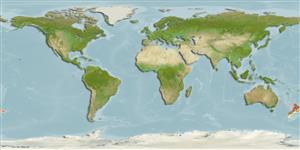Pycnogonida |
Pantopoda |
Nymphonidae
Environment: milieu / climate zone / تغييرات عمق / distribution range
بوم شناسي
; تغييرات عمق 0 - 540 m (مرجع 9). Subtropical
Southwest Pacific: Australia and New Zealand.
Length at first maturity / Size / Weight / سن
بلوغ: Lm ? range ? - ? cm
S. West Pacific: The above specimens increase geographic distribution for the species to the east and west of North Island, more than double the previously known depth range. Clark's specimen came from New South Wales, Australia, in 540 m. Size small, leg span about 27 mm. Trunk moderately slender, lateral processes separated by their diameters or slightly less, with small rounded dorsodistal tubercles. Neck moderately long, with small rounded tubercle dorsal to each chelifore insertion, oviger implantations at posterior, against first lateral processes. Ocular tubercle a tall slender cone with distal eyes. Proboscis short, distally rounded. Abdomen short. Chelifores very large, scapes divergent. Chelae palms short, fingers long, both curved ventrally, overlap at tips. Immovable fingers with about 25 slender teeth, movable fingers with more than twice as many much smaller teeth. Palps with segment 2 shorter than 3, segments 4 and 5 subequal in length, with few distal setae. Ovigers with slender long fifth segment swollen distally, with few lateral setae. Strigilis claw with 9 - 10 ventral lobes. Legs slender, with few setae. Propodus about twice tarsus length, both without spines on soles, with few tiny setae. Claw moderately short, auxilliary claws very curved, about 0.6 as long as main claw. Male cement gland ventral with 7 low tubes, but mostly more, up to 11 per leg, with shortest tube proximal, longest tube distally (Figure 1G). Distal tubes as wide as tall (Ref. 9)
Life cycle and mating behavior
بلوغ | تولید مثل | تخم ریزی | Eggs | Fecundity | Larvae
Members of the class Pycnogonida are gonochoric and sexually dimorphic. During copulation, male usually suspends itself beneath the female. Fertilization occurs as the eggs leave the female's ovigers. Males brood the egg masses until they hatch. Life cycle: Eggs hatch into protonymphon larva then to adults.
مآخذ اصلی
مراجع | هماهنگ كننده | همكاران
Child, C.A. 1998 The marine fauna of New Zealand: Pycnogonida (sea spiders). NIWA Biodiversity Memoire 109. National Institute of Water and Atmospheric Research (NIWA). Washington, D.C. 20530, USA. 71 p. + Figure 2A-G, 3A-F, 4, 5. (مرجع 9)
وضعيت در فهرست قرمز IUCN
(مرجع 130435: Version 2025-1)
وضعيت از نظر سايتس (مرجع 108899)
Not Evaluated
Not Evaluated
خطر برای انسان ها
استفاده انسانی
| FishSource |
ابزارها
اطلاعات بيشتر
Trophic EcologyFood items (preys)
تركيب غذايي
مصرف غذايي
شکارچیان
Population dynamicsرشد
Max. ages / sizes
Length-weight rel.
Length-length rel.
نوسانات طولی
Mass conversion
فراواني
Life cycleتولید مثلبلوغFecundityتخم ریزیEggsنمو تخمLarvae PhysiologyOxygen consumption
Human RelatedStamps, coins, misc.
منابع اينترنتي
Estimates based on models
Preferred temperature
(Ref.
115969): 11 - 19.4, mean 13.7 (based on 62 cells).
طبقه قيمت
Unknown.
